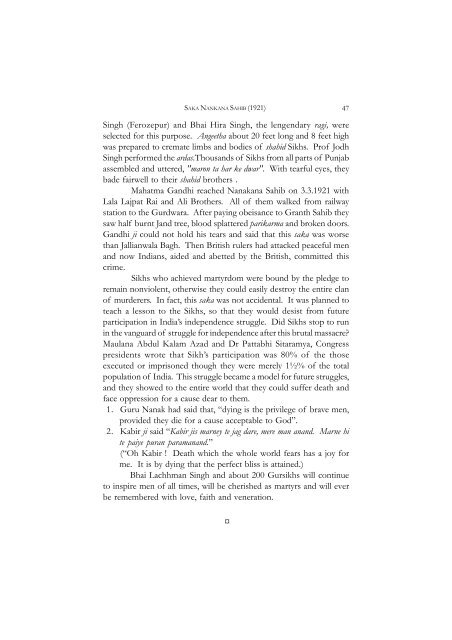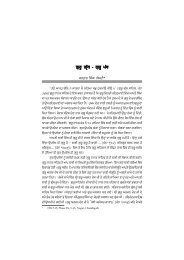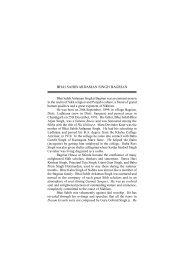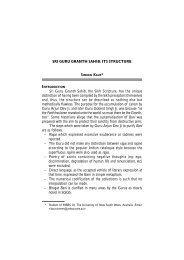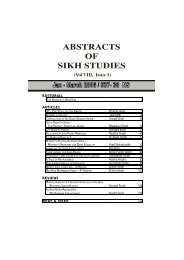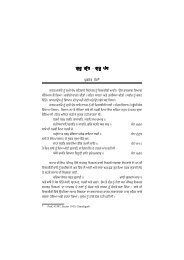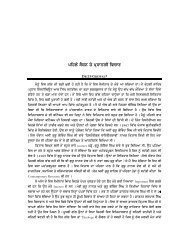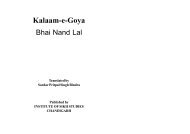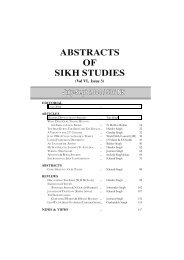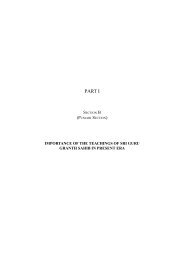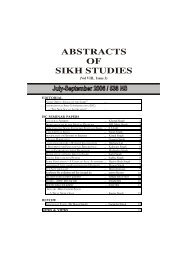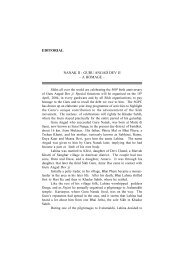editorial articles reviews news & views - Institute of Sikh Studies
editorial articles reviews news & views - Institute of Sikh Studies
editorial articles reviews news & views - Institute of Sikh Studies
Create successful ePaper yourself
Turn your PDF publications into a flip-book with our unique Google optimized e-Paper software.
SAKA NANKANA SAHIB (1921)<br />
47<br />
Singh (Ferozepur) and Bhai Hira Singh, the lengendary ragi, were<br />
selected for this purpose. Angeetha about 20 feet long and 8 feet high<br />
was prepared to cremate limbs and bodies <strong>of</strong> shahid <strong>Sikh</strong>s. Pr<strong>of</strong> Jodh<br />
Singh performed the ardas.Thousands <strong>of</strong> <strong>Sikh</strong>s from all parts <strong>of</strong> Punjab<br />
assembled and uttered, "maron ta har ke dwar". With tearful eyes, they<br />
bade fairwell to their shahid brothers .<br />
Mahatma Gandhi reached Nanakana Sahib on 3.3.1921 with<br />
Lala Lajpat Rai and Ali Brothers. All <strong>of</strong> them walked from railway<br />
station to the Gurdwara. After paying obeisance to Granth Sahib they<br />
saw half burnt Jand tree, blood splattered parikarma and broken doors.<br />
Gandhi ji could not hold his tears and said that this saka was worse<br />
than Jallianwala Bagh. Then British rulers had attacked peaceful men<br />
and now Indians, aided and abetted by the British, committed this<br />
crime.<br />
<strong>Sikh</strong>s who achieved martyrdom were bound by the pledge to<br />
remain nonviolent, otherwise they could easily destroy the entire clan<br />
<strong>of</strong> murderers. In fact, this saka was not accidental. It was planned to<br />
teach a lesson to the <strong>Sikh</strong>s, so that they would desist from future<br />
participation in India’s independence struggle. Did <strong>Sikh</strong>s stop to run<br />
in the vanguard <strong>of</strong> struggle for independence after this brutal massacre<br />
Maulana Abdul Kalam Azad and Dr Pattabhi Sitaramya, Congress<br />
presidents wrote that <strong>Sikh</strong>’s participation was 80% <strong>of</strong> the those<br />
executed or imprisoned though they were merely 1½% <strong>of</strong> the total<br />
population <strong>of</strong> India. This struggle became a model for future struggles,<br />
and they showed to the entire world that they could suffer death and<br />
face oppression for a cause dear to them.<br />
1. Guru Nanak had said that, “dying is the privilege <strong>of</strong> brave men,<br />
provided they die for a cause acceptable to God”.<br />
2. Kabir ji said “Kabir jis marney te jag dare, mere man anand. Marne hi<br />
te paiye puran paramanand.”<br />
(“Oh Kabir ! Death which the whole world fears has a joy for<br />
me. It is by dying that the perfect bliss is attained.)<br />
Bhai Lachhman Singh and about 200 Gursikhs will continue<br />
to inspire men <strong>of</strong> all times, will be cherished as martyrs and will ever<br />
be remembered with love, faith and veneration.<br />
¤


